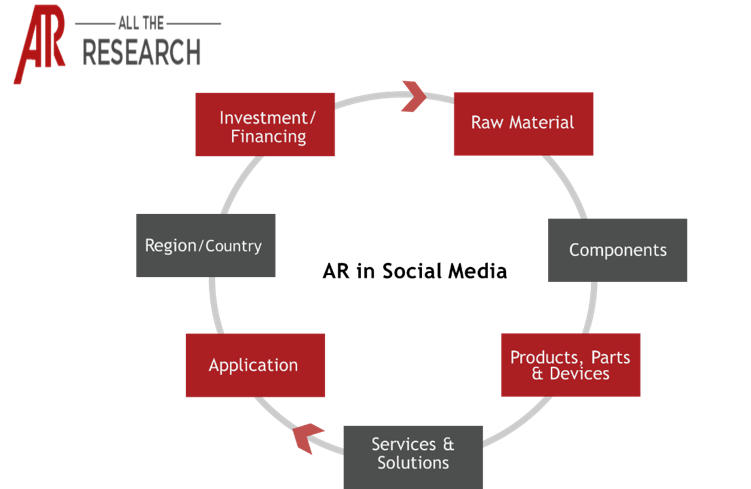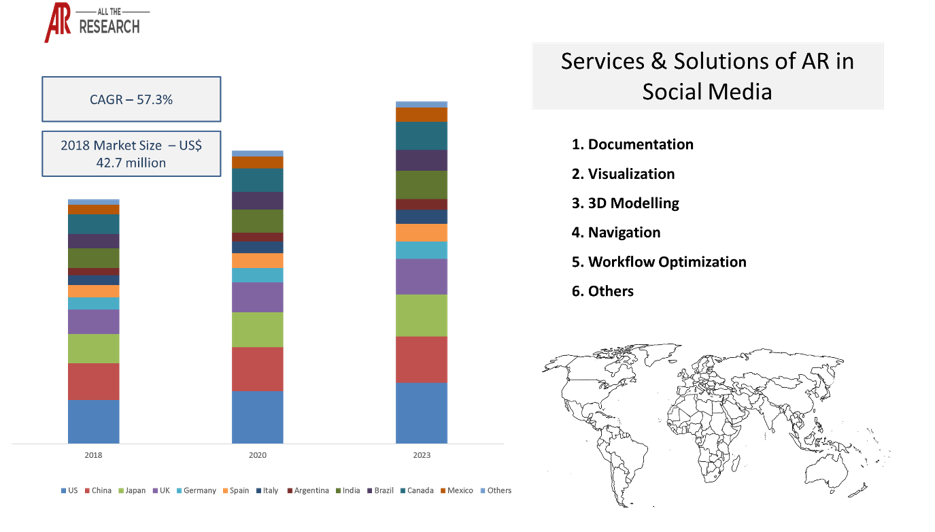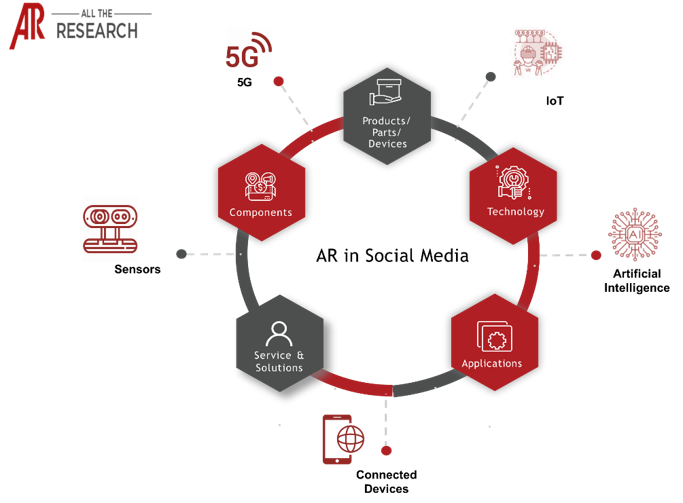The Global AR in Social Media Market was valued at USD 42.7 million in 2018 and is expected to reach USD XX million in 2026, growing at a CAGR of 57.3% by 2027. The AR technology is being fully utilized by many companies to provide the user with a more personalized and integrated experience. The growth of AR in social media ecosystem is mainly propelled by the growing use of mobile or connected devices to better integrate the apps with AR.
AR is helping to make social media more interactive, 3D-oriented, and fantastically shareable. For instance, Niantic, Inc. has developed an augmented reality mobile game named Pokémon Go, a breakout hit of 2016. This application has proved that AR in social media ecosystem was not just for selfies or proof of concept; it is much beyond the virtual playground. Another key application of AR in social media ecosystem is that it helps users imitate in-store shopping by providing the chance to use filters and other AR features to try out products for themselves. Some of the popular social media websites are incorporating AR to deliver personalized learning experiences. For instance, 3D advertisements are created using AR where the audience not only sees but feels the ads around them, which gives an immersive experience.
An increasing number of companies are investing in AR technology. The foremost reason why AR has become such a promising technology is that many companies are now utilizing the potential of these technologies by creating real-time image filters and a geo-tagging function that enables users to get information about the locations of their family and friends. AR technologies have enabled many brands to manage audience engagement impressively. For instance, Facebook has aligned with over 700 brands to accomplish the companies’ AR plan of developing an enhanced advertising platform powered by augmented reality technology.
Further, AR is being progressively used by companies to gain more and more footprints in social media marketing and beyond. Various brands such as Lenskart and Shoppers Stop are leveraging AR experiences on social media platforms like Facebook to interact or connect with customers. Also, YouTube, with its many social media elements, has recently added Snapchat-like AR selfie filters for YouTube Stories. Before Snapchat, Google Glass was at the forefront of the game-changing technology, which has incorporated the power of augmented environment into the platform.

|
Raw Material |
Components |
Products, Parts and Devices |
Services & Solutions |
Application |
|
Silicon |
Sensors |
Handheld Devices |
Documentation |
3D modelling/ design |
|
GaN |
Camera |
Visualization |
||
|
Glass |
IMU |
3D Modelling |
||
|
SiC |
Processor |
Navigation |
||
|
Metals |
Modules |
Workflow Optimization |
||
|
Others |
Graphics (Cards) |
Others |
||
|
Audio (ICs) |
||||
|
Memory |
||||
|
Display |
||||
|
Others |
In the products, parts and devices segment, handheld devices account for a significant share in the AR in social media ecosystem. Users are now creating immense potential for AR technologies. The rapid utilization of tablets, smartphones, and other personalized devices has enabled them to explore and create a brand-new experience of engaging themselves in events and initiatives. AR has allowed users to display virtual images by accessing smartphone features such as GPS, camera, sensors, and display. From location-based apps and 3D gaming apps to image recognition, AR is widely executed to deliver a seamless user experience that can take user-generated content to another level and can ensure that social media continues to be the ideal platform for marketing kings, highly engaged enthusiasts, and brilliant brands.
In the component, parts and devices segment, camera accounted for a majority share in AR in social media ecosystem. Camera can be effectively used to display virtual images and AR selfie filters. Hence, they are expected to hold the highest share in the market. For instance, Facebook has announced camera effects platform that turns smartphone cameras into the first AR platform, giving an opportunity to developers and artists to create effects for the Facebook camera. The platform urges developers and designers to develop interactive effects and features. This AR platform has enabled Facebook to build a gigantic creative force rather than a small in-house team like Snapchat.
The global AR in social media ecosystem was valued at US$ 42.7 million in 2018 and is expected to reach US$ 411.4 million by the year 2023, growing at a CAGR of 57.3%. Social media companies are one of the most prominent users of augmented reality (AR) technologies. Companies such as Facebook, Instagram, Snapchat, etc., are already using AR for designing an integrated and interactive user experience.
The US is leading the market in terms of AR adoption in social media platforms. The presence of leading companies in the country deploying AR technology such as Facebook, Inc., Snap Inc., and others, and the high adoption rate of AR are some of the factors for the dominance of the country. Further, rising investments by social media companies in the country are also creating lucrative opportunities for AR technology.

There are many trends that are having an impact on the market forecast. These, when evaluated from a company’s perspective, can drive growth. Our numerous consulting projects have generated sizeable synergies across all regions and all sizes of companies.
|
Company |
Ecosystem Positioning |
Total Revenue (2018) |
Industry |
Region |
|---|---|---|---|---|
|
Google LLC |
Products, Parts and Devices |
US$ 136,819.0 Mn |
Consumer Electronics, Retail, Others |
Global |
|
Facebook, Inc. |
Application |
US$ 55,838.0 Mn |
Social Media |
Global |
|
Snap, Inc. |
Application |
US$ 404.5 Mn |
Social Media |
Global |
|
Apple, Inc. |
Products, Parts and Devices |
US$ 265.6 Mn |
Consumer Electronics |
Global |
|
Samsung Electronics Co. |
Products, Parts and Devices |
US$ 210,265.7 Mn |
Consumer Electronics |
Global |
|
Sony Corporation |
Products, Parts and Devices |
US$ 77,579.3 Mn |
Consumer Electronics |
Global |
Very few markets have the interconnectivity with other markets like AR. Our Interconnectivity module focuses on the key nodes of heterogeneous markets in detail. Artificial intelligence, industrial IoT, 5g technology, gaming technology, and connected devices markets are some of our key researched markets.

|
Trends |
Application |
Impact |
|---|---|---|
|
The use of AR in social media is gaining traction nowadays. Giants in social media such as Instagram, Facebook, and Snapchat have started incorporating augmented reality into their websites or apps to provide users a more enhanced experience and a new way to engage people on social media. |
3D modelling/ design |
2.28% |
|
Development of customizable chatbots to mimic intelligent conversation without the presence of a human being. Facebook chatbots are one such application that has rapidly gained popularity and has provided marketers a new tool to leverage. |
XX |
|
|
Growing adoption of AR technology to add more digital elements for a better and more engaging experience. Various social media platforms are investing funds considerably for optimizing their AR capabilities. |
XX |
XX |

Ask for free product review call with the author

Share your specific research requirements for a customized report

Request for due diligence and consumer centric studies

Request for study updates, segment specific and country level reports
Introduction
Ask for Customization
Sensitivity Analysis
Global AR in Social Media Ecosystem Snapshot
Global AR in Social Media Ecosystem Broad Heads
Global AR in Social Media Ecosystem Trends
Trend Mapping
Overview
Regulatory Mapping
Global AR in Social Media Ecosystem Sizing & Volume
Cross-segmentation
Competitive Intelligence
Top Industry Players vs Trend Tagging
Company Profiling Summary
Company List & Fundamentals
Global AR in Social Media Ecosystem Events & Rationale
R&D, Technology and Innovation
Research Methodology and Approach
Assumptions/ Inferences
